

Compact Muon Solenoid
LHC, CERN
| CMS-BPH-16-003 ; CERN-EP-2018-224 | ||
| Studies of $\mathrm{B_{s2}^{*}(5840)^{0}}$ and $\mathrm{B_{s1}(5830)^{0}}$ mesons including the observation of the $\mathrm{B_{s2}^{*}(5840)^{0}} \to \mathrm{B^0} \mathrm{K_{S}^0}$ decay in proton-proton collisions at $\sqrt{s} = $ 8 TeV | ||
| CMS Collaboration | ||
| 10 September 2018 | ||
| Eur. Phys. J. C 78 (2018) 939 | ||
| Abstract: Measurements of $\mathrm{B_{s2}^{*}(5840)^{0}}$ and $\mathrm{B_{s1}(5830)^{0}}$ mesons are performed using a data sample of proton-proton collisions corresponding to an integrated luminosity of 19.6 fb$^{-1}$ , collected with the CMS detector at the LHC at a centre-of-mass energy of 8 TeV. The analysis studies $P$-wave $\mathrm{B_{s}^0}$ meson decays into $\mathrm{B^{(*)+}}\mathrm{K^{-}}$ and $\mathrm{B^{(*)0}}\mathrm{K_{S}^{0}}$, where the $\mathrm{B^{+}}$ and $\mathrm{B^{0}}$ mesons are identified using the decays $\mathrm{B^{+}}\to\mathrm{J/\psi}\mathrm{K^{+}}$ and ${\mathrm{B^{0}}\to\mathrm{J/\psi}\mathrm{K^{*}(892)^0}} $. The masses of the $P$-wave $\mathrm{B_{s}^0}$ meson states are measured and the natural width of the $\mathrm{B_{s2}^{*}(5840)^{0}}$ state is determined. The first measurement of the mass difference between the charged and neutral $\mathrm{B^{*}}$ mesons is also presented. The $\mathrm{B_{s2}^{*}(5840)^{0}}$ decay to $\mathrm{B^{0}}\mathrm{K_{S}^{0}}$ is observed, together with a measurement of its branching fraction relative to the $\mathrm{B_{s2}^{*}(5840)^{0}} \to \mathrm{B^{+}} \mathrm{K^{-}}$ decay. | ||
| Links: e-print arXiv:1809.03578 [hep-ex] (PDF) ; CDS record ; inSPIRE record ; HepData record ; CADI line (restricted) ; | ||
| Figures | |

png pdf |
Figure 1:
Invariant mass distributions of (a) $ {\mathrm {J} / \psi} {{{\mathrm {K}}} ^+} $ and (b) $ {\mathrm {J} / \psi} {{{\mathrm {K}}} ^{*0}} $ candidates in data with the fit results superimposed. The points represent the data, with the vertical bars giving the corresponding statistical uncertainties. The thick curves are results of the fits, the dash-dotted lines display the signal contributions, and the short-dashed lines show the combinatorial background contributions. The long-dashed line shows in (a) the contribution from the $ {{\mathrm {B}} ^+} \to {\mathrm {J} / \psi} {\pi ^+} $ decay, and in (b) the contribution from partially reconstructed $ {\mathrm {B}} \to {\mathrm {J} / \psi} {{{\mathrm {K}}} ^{*0}} \mathrm {X}$ decays. The dashed line in (b) displays the contribution from swapping $ {{{\mathrm {K}}} ^\pm} \to {\pi ^\pm} $ in the reconstruction. |
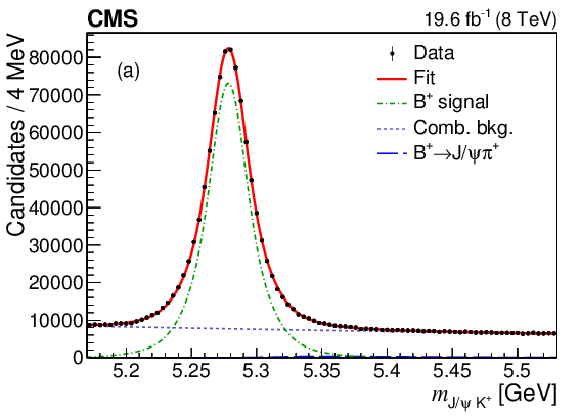
png pdf |
Figure 1-a:
Invariant mass distribution of $ {\mathrm {J} / \psi} {{{\mathrm {K}}} ^+} $ candidates in data with the fit results superimposed. The points represent the data, with the vertical bars giving the corresponding statistical uncertainties. The thick curves are results of the fits, the dash-dotted lines display the signal contributions, and the short-dashed lines show the combinatorial background contributions. The long-dashed line shows the contribution from the $ {{\mathrm {B}} ^+} \to {\mathrm {J} / \psi} {\pi ^+} $ decay. |
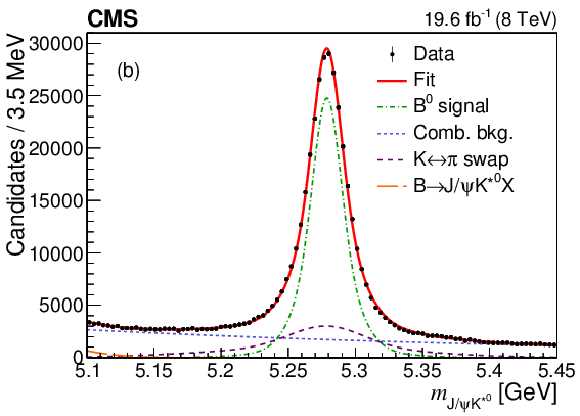
png pdf |
Figure 1-b:
Invariant mass distribution of $ {\mathrm {J} / \psi} {{{\mathrm {K}}} ^{*0}} $ candidates in data with the fit results superimposed. The points represent the data, with the vertical bars giving the corresponding statistical uncertainties. The thick curves are results of the fits, the dash-dotted lines display the signal contributions, and the short-dashed lines show the combinatorial background contributions. The long-dashed line shows the contribution from partially reconstructed $ {\mathrm {B}} \to {\mathrm {J} / \psi} {{{\mathrm {K}}} ^{*0}} \mathrm {X}$ decays. The dashed line displays the contribution from swapping $ {{{\mathrm {K}}} ^\pm} \to {\pi ^\pm} $ in the reconstruction. |
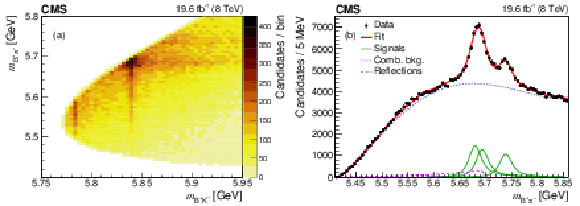
png pdf |
Figure 2:
(a) Two-dimensional distribution of $ {m_{{{\mathrm {B}} ^+} {{{\mathrm {K}}} ^-}}} $ versus $ {m_{{{\mathrm {B}} ^+} {\pi ^-}}} $ in data. (b) The fitted $ {{{\mathrm {B}} ^+} {\pi ^-}} $ invariant mass distribution. The points represent the data, the thick solid curve is the fit projection, the thin lines indicate the three excited $ {{\mathrm {B}} ^0} $ signal contributions, the short-dashed curve is the combinatorial background, and the long-dashed lines show the contributions from the excited $ {{\mathrm {B}} ^0_ {\mathrm {s}}} $ decays. |

png pdf |
Figure 2-a:
Two-dimensional distribution of $ {m_{{{\mathrm {B}} ^+} {{{\mathrm {K}}} ^-}}} $ versus $ {m_{{{\mathrm {B}} ^+} {\pi ^-}}} $ in data. |
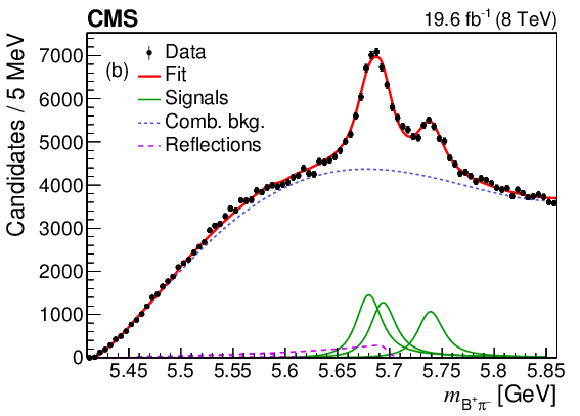
png pdf |
Figure 2-b:
The fitted $ {{{\mathrm {B}} ^+} {\pi ^-}} $ invariant mass distribution. The points represent the data, the thick solid curve is the fit projection, the thin lines indicate the three excited $ {{\mathrm {B}} ^0} $ signal contributions, the short-dashed curve is the combinatorial background, and the long-dashed lines show the contributions from the excited $ {{\mathrm {B}} ^0_ {\mathrm {s}}} $ decays. |
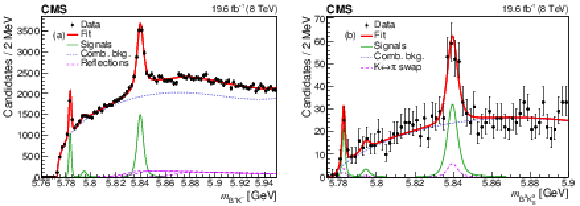
png pdf |
Figure 3:
Invariant mass distributions of (a) $ {{{\mathrm {B}} ^+} {{{\mathrm {K}}} ^-}} $ and (b) $ {{{\mathrm {B}} ^0} {{{\mathrm {K}}} ^0_{\mathrm {S}}}} $ candidates with the results of the fit overlaid. The points represent the data, the thick solid curves are the results of the overall fits, and the thin solid lines display the signal contributions. The short-dashed lines show the combinatorial background contributions. The long-dashed lines show: in (a) the contributions from excited $ {{\mathrm {B}} ^0} $ meson decays, and in (b) the contributions from swapping $ {{{\mathrm {K}}} ^\pm} \to {\pi ^\pm} $ in the reconstruction of the $ {{\mathrm {B}} ^0} $ mesons. |
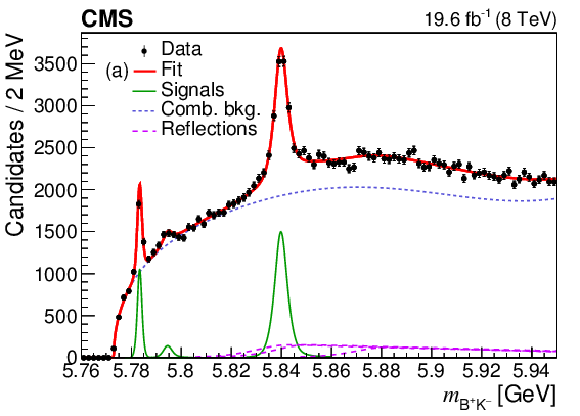
png pdf |
Figure 3-a:
Invariant mass distribution of $ {{{\mathrm {B}} ^0} {{{\mathrm {K}}} ^0_{\mathrm {S}}}} $ candidates with the results of the fit overlaid. The points represent the data, the thick solid curves are the results of the overall fits, and the thin solid lines display the signal contributions. The short-dashed lines show the combinatorial background contributions. The long-dashed lines show the contributions from swapping $ {{{\mathrm {K}}} ^\pm} \to {\pi ^\pm} $ in the reconstruction of the $ {{\mathrm {B}} ^0} $ mesons. |

png pdf |
Figure 3-b:
Invariant mass distributions of (a) $ {{{\mathrm {B}} ^+} {{{\mathrm {K}}} ^-}} $ and (b) $ {{{\mathrm {B}} ^0} {{{\mathrm {K}}} ^0_{\mathrm {S}}}} $ candidates with the results of the fit overlaid. The points represent the data, the thick solid curves are the results of the overall fits, and the thin solid lines display the signal contributions. The short-dashed lines show the combinatorial background contributions. The long-dashed lines show: in (a) the contributions from excited $ {{\mathrm {B}} ^0} $ meson decays, and in (b) the contributions from swapping $ {{{\mathrm {K}}} ^\pm} \to {\pi ^\pm} $ in the reconstruction of the $ {{\mathrm {B}} ^0} $ mesons. |
| Tables | |

png pdf |
Table 1:
Results on the masses, mass differences, and natural widths of the $ {{\mathrm {B}} ^{(*)}_{{\mathrm {s}}1,2}} $ mesons from previous measurements. The mass differences are defined as $ {\Delta M_{{{\mathrm {B}} _{{\mathrm {s}}1}}}^{\pm}} \equiv {M({{\mathrm {B}} _{{\mathrm {s}}1}})-M_{{{\mathrm {B}} ^{*+}}}^{\mathrm {PDG}}-M_{{{{\mathrm {K}}} ^-}}^{\mathrm {PDG}}} $ and $ {\Delta M_{{{\mathrm {B}} ^{*}_{{\mathrm {s}}2}}}^{\pm}} \equiv {M({{\mathrm {B}} ^{*}_{{\mathrm {s}}2}})-M_{{{\mathrm {B}} ^+}}^{\mathrm {PDG}}-M_{{{{\mathrm {K}}} ^-}}^{\mathrm {PDG}}} $, where the PDG superscript refers to the world-average mass values at the time of each publication. |

png pdf |
Table 2:
The observed signal yields ($N$), natural widths ($\Gamma $), and mass differences from the fits to the $ {m_{{{\mathrm {B}} {{\mathrm {K}}}}}} $ distributions in data. The uncertainties are statistical only. |
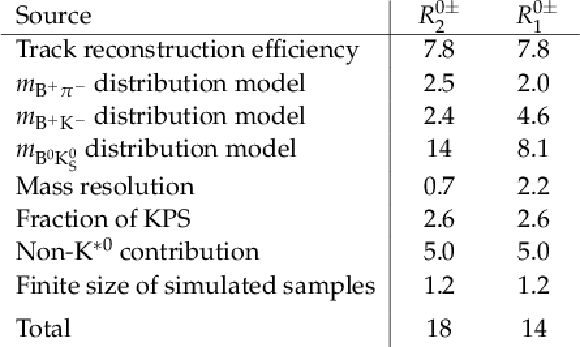
png pdf |
Table 3:
Relative systematic uncertainties in percent in the ratios $ {R^{0\pm}_{2}} $ and $ {R^{0\pm}_{1}} $. |

png pdf |
Table 4:
Relative systematic uncertainties in percent in the ratios $ {R^{\pm}_{2*}} $, $ {R^{0}_{2*}} $, $ {R^{\pm}_{\sigma}} $, and $ {R^{0}_{\sigma}} $. |

png pdf |
Table 5:
Systematic uncertainties (in MeV) in the measured mass differences and natural width. The $ {{\mathrm {B}} ^{*}_{{\mathrm {s}}2}} $ width is measured only in the $ {{{\mathrm {B}} ^+} {{{\mathrm {K}}} ^-}} $ channel. |
| Summary |
| The $P$-wave $\mathrm{B_{s}^0}$ meson states are studied using a data sample corresponding to an integrated luminosity of 19.6 fb$^{-1}$ of proton-proton collisions collected by the CMS experiment at $\sqrt{s} = $ 8 TeV in 2012. Observation and evidence are reported for the decays $\mathrm{B_{s2}^{*}(5840)^{0}} \to \mathrm{B^0} \mathrm{K_{S}^0}$ and ${\mathrm{B_{s1}(5830)^{0}}\to\mathrm{B^{*0}}\mathrm{K_{S}^{0}}} $, respectively. Four ratios of branching fractions and two ratios of production cross sections multiplied by the branching fractions of the $P$-wave $\mathrm{B_{s}^0}$ mesons into a B meson and kaon are measured. In addition, the differences between the $\mathrm{B^{*}_{s1,2}} $ mass and the sum of the B meson and kaon mass are determined, as well as the $\mathrm{B_{s2}^{*}(5840)^{0}}$ natural width. Finally, using a new approach, the mass differences $M_{\mathrm{B^{0}}}-M_{\mathrm{B^{+}}}$ and $M_{\mathrm{B^{*0}}}-M_{\mathrm{B^{*+}}}$ are measured, where the latter is determined for the first time. |
| References | ||||
| 1 | F. E. Close and Z.-p. Li | Effective heavy quark theory | PLB 289 (1992) 143 | hep-ph/9206217 |
| 2 | A. G. Grozin | Heavy quark effective theory | Springer Tracts Mod. Phys. 201 (2004) 1 | |
| 3 | CDF Collaboration | Observation of orbitally excited $ \mathrm{B}_\mathrm{s} $ mesons | PRL 100 (2008) 082001 | 0710.4199 |
| 4 | D0 Collaboration | Observation and properties of the orbitally excited $ \mathrm{B}^*_{\mathrm{s}2} $ meson | PRL 100 (2008) 082002 | 0711.0319 |
| 5 | LHCb Collaboration | First observation of the decay $ \mathrm{B}_{\rm{s2}}^*(5840)^0 \to {\mathrm{B}}^{*+} {\mathrm {K}}^- $ and studies of excited $ {\mathrm{B}}^0_{\mathrm{s}} $ mesons | PRL 110 (2013) 151803 | 1211.5994 |
| 6 | CDF Collaboration | Study of orbitally excited B mesons and evidence for a new $ \mathrm{B}\pi $ resonance | PRD 90 (2014) 012013 | 1309.5961 |
| 7 | CMS Collaboration | The CMS experiment at the CERN LHC | JINST 3 (2008) S08004 | CMS-00-001 |
| 8 | CMS Collaboration | Description and performance of track and primary-vertex reconstruction with the CMS tracker | JINST 9 (2014) 10009 | CMS-TRK-11-001 1405.6569 |
| 9 | CMS Collaboration | Performance of CMS muon reconstruction in $ \mathrm{pp} $ collision events at $ \sqrt{s} = $ 7 TeV | JINST 7 (2012) P10002 | CMS-MUO-10-004 1206.4071 |
| 10 | CMS Collaboration | The CMS trigger system | JINST 12 (2017) P01020 | CMS-TRG-12-001 1609.02366 |
| 11 | CMS Collaboration | Search for the X(5568) state decaying into $ \mathrm{B}^{0}_{\mathrm{s}}\pi^{\pm} $ in proton-proton collisions at $ \sqrt{s}= $ 8 TeV | PRL 120 (2018) 202005 | CMS-BPH-16-002 1712.06144 |
| 12 | Particle Data Group, C. Patrignani et al. | Review of particle physics | CPC 40 (2016) 100001 | |
| 13 | CMS Collaboration | CMS tracking performance results from early LHC operation | EPJC 70 (2010) 1165 | CMS-TRK-10-001 1007.1988 |
| 14 | T. Sjostrand, S. Mrenna, and P. Skands | PYTHIA 6.4 physics and manual | JHEP 05 (2006) 026 | hep-ph/0603175 |
| 15 | D. J. Lange | The EvtGen particle decay simulation package | NIMA 462 (2001) 152 | |
| 16 | E. Barberio, B. van Eijk, and Z. W\cas | PHOTOS --- a universal Monte Carlo for QED radiative corrections in decays | CPC 66 (1991) 115 | |
| 17 | E. Barberio and Z. W\cas | PHOTOS -- a universal Monte Carlo for QED radiative corrections: version 2.0 | CPC 79 (1994) 291 | |
| 18 | GEANT4 Collaboration | $ GEANT4--A $ simulation toolkit | NIMA 506 (2003) 250 | |
| 19 | S. S. Wilks | The large-sample distribution of the likelihood ratio for testing composite hypotheses | Ann. Math. Statis. 9 (1938) 60 | |
| 20 | M. Pivk and F. R. Le Diberder | $ {}_\mathrm{s} $Plot: a statistical tool to unfold data distributions | NIMA 555 (2005) 356 | physics/0402083 |
| 21 | CMS Collaboration | Alignment of the CMS tracker with LHC and cosmic ray data | JINST 9 (2014) P06009 | CMS-TRK-11-002 1403.2286 |
| 22 | Z.-H. Wang, G.-L. Wang, H.-F. Fu, and Y. Jiang | The strong decays of orbitally excited $ \mathrm{B}^{*}_{\mathrm{sj}} $ mesons by improved Bethe-Salpeter method | PLB 706 (2012) 389 | 1202.1224 |
| 23 | Q.-F. Lu et al. | Excited bottom and bottom-strange mesons in the quark model | PRD 94 (2016) 074012 | 1607.02812 |
| 24 | X.-h. Zhong and Q. Zhao | Strong decays of heavy-light mesons in a chiral quark model | PRD 78 (2008) 014029 | 0803.2102 |
| 25 | P. Colangelo, F. De Fazio, F. Giannuzzi, and S. Nicotri | New meson spectroscopy with open charm and beauty | PRD 86 (2012) 054024 | 1207.6940 |

|
Compact Muon Solenoid LHC, CERN |

|

|

|

|

|

|